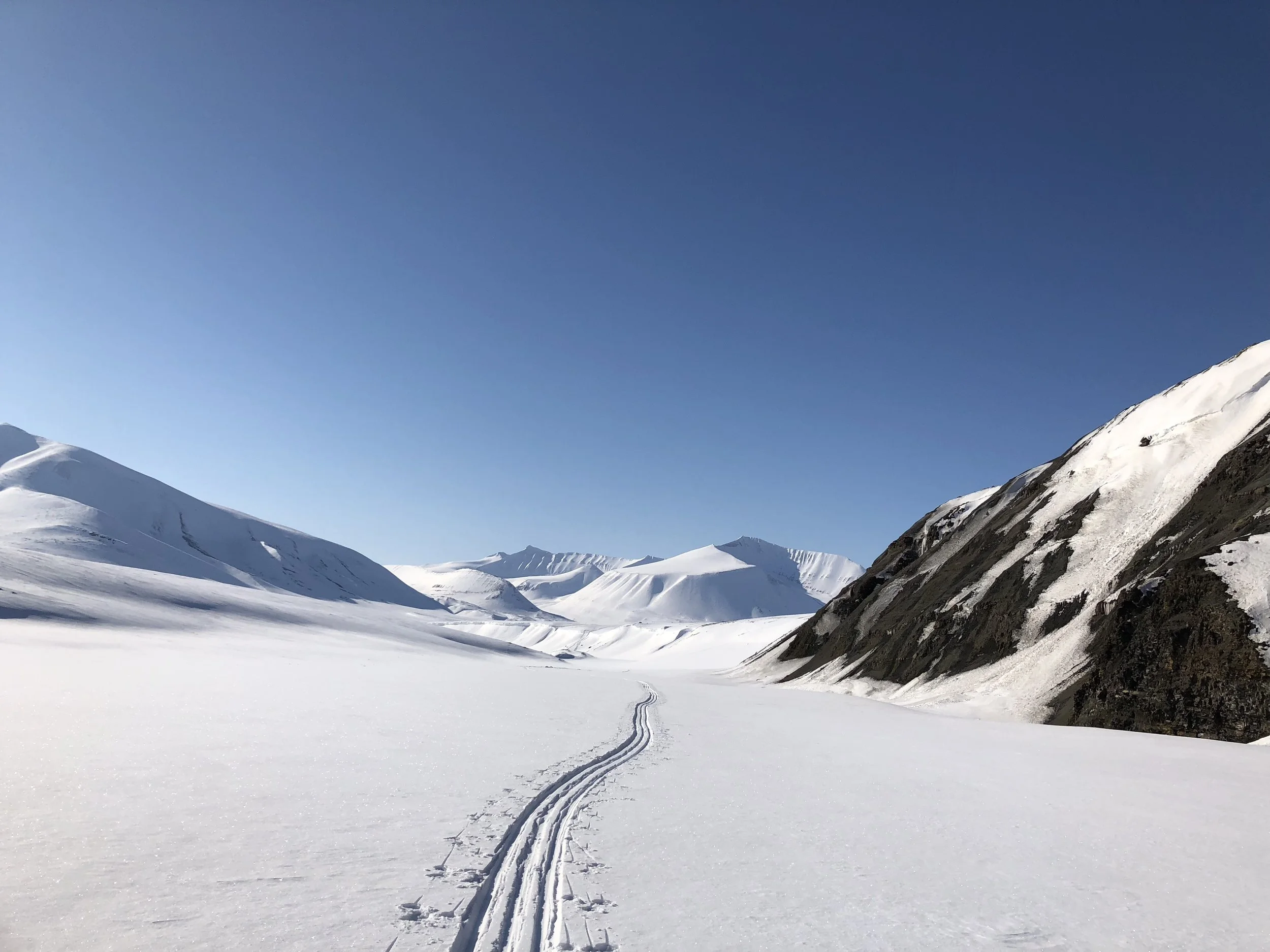
Svalbard Crossing - East to West
A Self-Supported Polar Expedition
22nd - 30th April 2026
Svalbard has that undeniable pull of the North. It occupies a special place on the edges of the map where your eye searches north, further north – and there it is. Cloaked in snow, shaped by the presence of polar bears, Svalbard stands apart from other snowy places. It has a unique remoteness, an ‘otherness’ that calls to a certain type of person - someone who can put their head down and keep trudging to cover the last miles of the day, someone thriving on the routines of expedition life, and longing to see what’s behind that next hill and the next. Always pushing beyond the horizon line. Svalbard is challenging, vast, and always a step beyond.
This expedition is an 7-day self-supported crossing starting in Agardhbukta and finishing in Longyearbyen. Before taking the skidoo transfer into the wild, we prepare in Longyearbyen, practising polar bear protection and checking our gear. From there, the journey begins on skis, pulling pulks and camping in polar tents.
The Crossing Highlights
Spend 6 nights, out in the remote wilderness of Svalbard!
120km Self supported on skis
Learn the skill of polar bear protection
Use the best polar equipment: pulks and Hilleberg tents
COST : £3095
DAYS: 9
LEVEL: 3
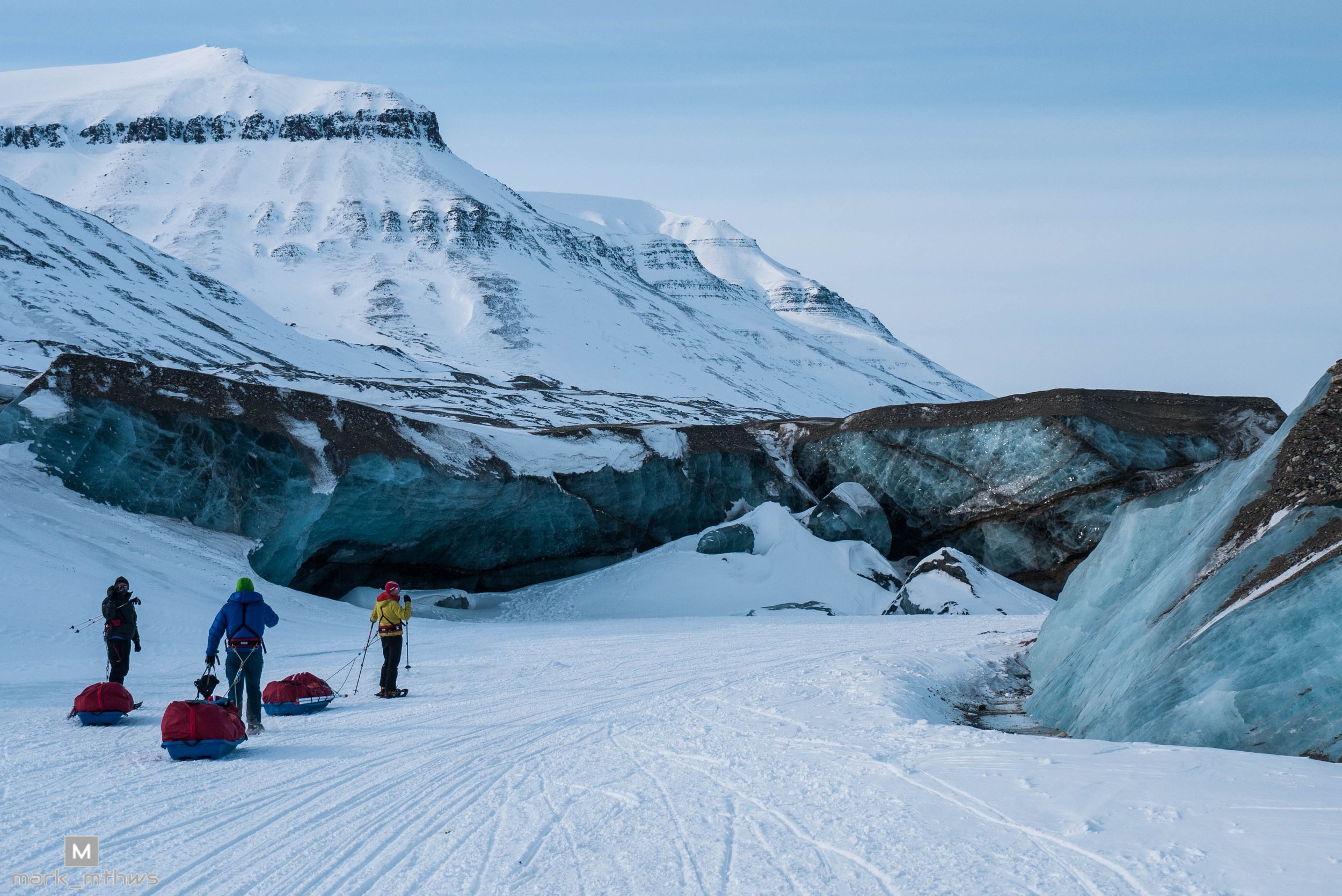
What to expect during your Svalbard Crossing
Explore Longyearbyen, a historic coal mining town, home to a museum, restaurants and hotels, and a good place for R&R after the expedition.
Learn the routines of expedition – set up tent and tripwire system, dig the cold air-well, and enjoy simple comforts like chocolate warmed in your pocket or a hot sweet drink at lunch break.
Teamwork: Work as part of a small team, sharing the load of daily tasks like setting up camp, cooking, and keeping watch.
Perfect your ski technique – learn how different snow and temperature affect your movement, apply waxes and skins to adapt to the terrain.
Take time for observation – long nights spent on polar bear watch, letting the eye and mind wander; taking time to photograph the incredible scenery; looking out for arctic foxes, reindeer, and maybe even a glimpse of a polar bear.
East to West crossing of Spitsbergen: The Largest Island in the Svalbard archipelago, this crossing involves 120km of sledge pulling up, over and through mountain ranges.
We only have limited places on each expedition, get in contact today and reserve your spot on our next adventure.
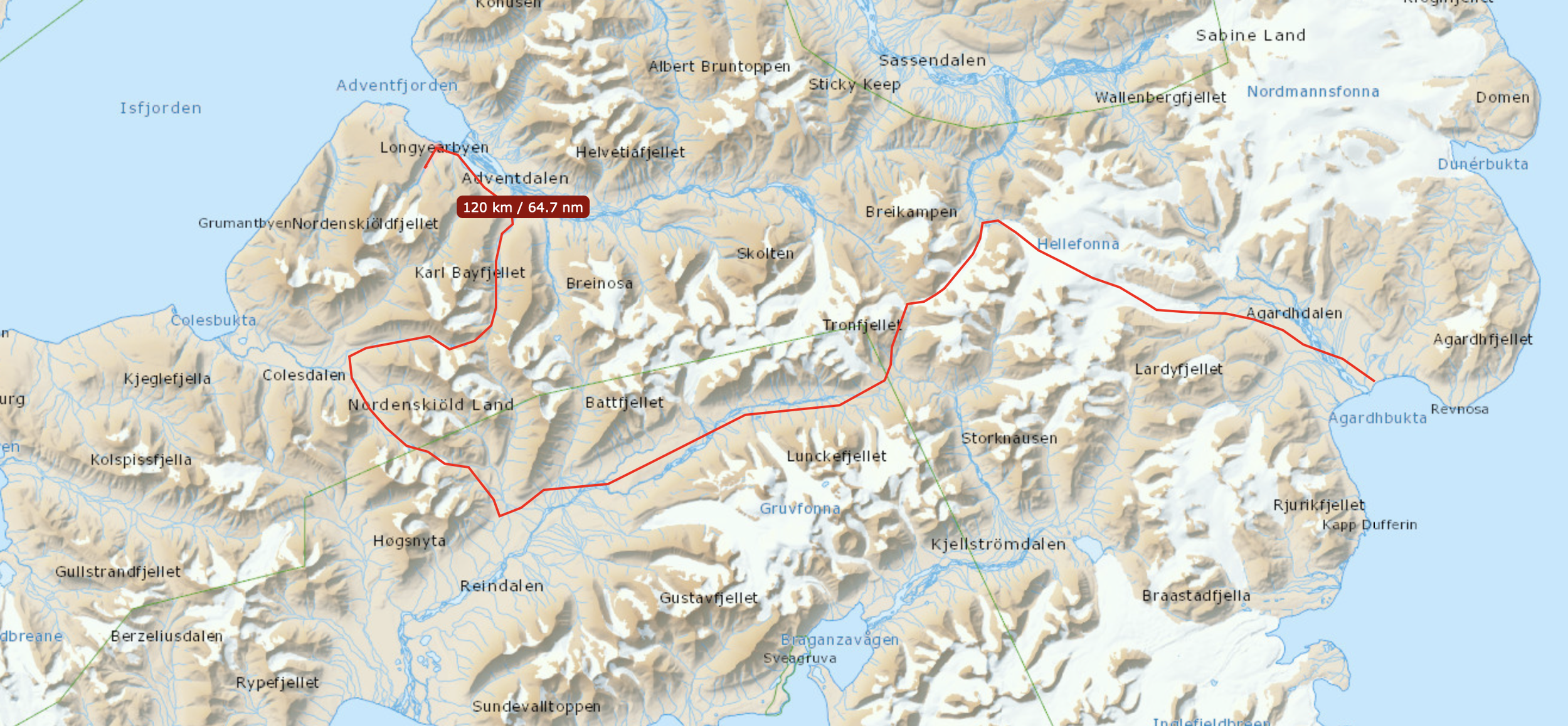
Expedition Itinerary
-
Today will be a busy day from the moment you land in Longyearbyen. Whether arriving on an early flight or having come the day before, we’ll hit the ground running with essential expedition preparations. We’ll gather to discuss any last-minute updates, then move on to testing the gear you’ll rely on in the field—stoves, tents, pulks—ensuring everything is in working order for the journey ahead.
Polar bear safety is a top priority, so we’ll take time to refresh our emergency protocols, covering bear watches, setting up the tripwire system, and handling the flare pistol and rifle. Once we’re confident in our systems, it’s time to pack the pulks, double-check everyone’s personal equipment, and fine-tune skis, bindings, and any other necessary gear.
-
Today marks the real start of the expedition. We meet our local agent in Longyearbyen, who supports us with logistics and provides the insulated suits and helmets needed for the snowmobile transfer. After a final briefing and equipment check, we load up and begin the three-hour journey east, travelling in pairs and sharing the driving. The route takes us across wide valleys and frozen fjords with the sharp outline of Svalbard’s mountains ahead.
At Agardhbukta, the mountains rise on our left and the sea ice opens to our right. Here we say goodbye to our drivers — a quiet, slightly daunting moment as the machines turn back and the only sounds left are wind and skis. From here, we begin our first ascent west towards the Hellefonna massif, aiming to reach high ground beneath its main summits.
By evening, we expect to meet our northern team, already ten days into their own journey. It’s a lively mix of old and new faces, and a chance to refine camp craft, ski movement, and daily routines as we settle into the rhythm of the expedition.
-
We make a steady ascent up the Sveigbreen glacier, gaining height gradually as the terrain opens into the upper basins of Hellefonna. Depending on conditions, our route takes us either over the Hellefonna plateau and down the Innerbreen glacier, or via the Såtebreen glacier into the Oppdalen valley. Both options offer expansive views across the eastern ranges and a good sense of scale within the glacier systems.
By late afternoon, we establish our second camp near the base of the Såtebreen. The descent into Oppdalen brings some welcome downhill skiing and a change of pace after the climb, with wide views from the high plateau of Hellefonna before dropping back into the valley.
-
We start the day with a gradual descent into the broad valley of Reindalspasset — passet meaning “the pass” in Norwegian. It’s a wide, open glacial corridor, more than eight kilometres across at its widest point. From the valley floor we begin to climb again, heading up onto the Bermesterbreen (breen meaning glacier), following a steady line over compact snow and ice.
The route continues across the Drønbreen and then onto the open expanse of the Rugaasfonna, an icefield or snowfield typical of this part of Svalbard. From here, a smooth descent takes us over the Kokbreen glacier and back into Reindalspasset.
By late afternoon, we establish camp once more in the valley, surrounded by the glacier systems we’ve crossed during the day — a reminder of the scale and isolation of the terrain we’re moving through.
-
Today we spend the full day travelling through the vast Reindalen valley. It’s one of Svalbard’s broadest valleys — a long, open corridor carved by ice, stretching for tens of kilometres between low ridges and isolated nunataks. The terrain here feels different from the previous days: wider, quieter, and with a slower rhythm as the valley draws us gradually towards the coast.
The travel is steady, crossing frozen rivers and undulating snowfields with only occasional climbs. This is a day to settle into efficient pulk travel — refining pacing, navigation, and teamwork across long, open ground.
As we move further east, we gain our first glimpse of the sea — a thin silver line on the horizon that marks the edge of the island. Camp tonight is set within the Reindalen system, where the scale of the landscape becomes most apparent: vast distances, soft light, and the quiet sense of isolation that defines Svalbard’s interior.
-
We continue west through Semmeldalen and into Skiferdalen, following broad glacial valleys that gradually narrow before opening once more towards Colesdalen. The landscape shifts throughout the day — from long rolling snowfields to steeper terrain where the valley sides close in and the sense of scale returns.
As we gain height, new views of the coast begin to appear, looking out towards Colesbukta and the frozen expanse of the fjord. It’s a striking contrast to the inland ice we’ve travelled through — the light sharper, the air carrying a hint of the sea.
By late afternoon, we find a suitable site for camp with views down towards the coast, marking the transition from Svalbard’s high interior to its outer valleys.
-
Our final big day on skis begins with the ascent towards Longyearpasset — a steep climb that marks the last major effort of the expedition. We take a steady, measured pace, hauling the pulks up through the pass that links the outer valleys with the glacier systems above Longyearbyen. The views from the top are worth the work: behind us lie the long valleys of Semmeldalen and Colesdalen, ahead the sweeping descent of the Longyearbreen glacier.
From the col, we begin our final ski down the glacier, winding towards the valley that leads back to Longyearbyen. The landscape changes quickly — from the quiet of the high ice to the first signs of the settlement below. By late afternoon we reach town, where the sound of engines and the sight of buildings feel almost out of place after days on the ice.
Once back, we unload and dry equipment, then gather for a final meal together. It’s a time to reflect on the journey, the challenges faced, and the rhythm of expedition life that’s carried us through the Arctic landscape.
-
This day is kept flexible to allow for changing conditions or to make the most of a suitable weather window. Strong winds and poor visibility can quickly alter plans in Svalbard, so maintaining a reserve day gives us the freedom to move safely and efficiently within the conditions.
If the weather allows, this may become a summit day — an opportunity to climb one of the surrounding peaks for views across the glacier systems and out towards the coast. Otherwise, it’s a chance to rest, make repairs, review navigation, and consolidate camp routines.
Days like this are an essential part of expedition life, balancing ambition with patience and using the time to stay organised and ready for the next stage.
-
After breakfast, transfers to the airport mark the end of the journey. Bags are packed, flights checked and we say our big goodbyes.
The Details
Cost per place on the expedition: £3095
-
Accommodation – 2 night hostel, 6 nights in tents
All in-country transfers, Excluding airport transfers
Meals – All meals on from leaving Longyearbyen D2 to arriving back D7.
Use of pulk system
Mountain tents, stoves + cooking equipment.
Polar bear protection systems. (trip wire system, Signal pistols, high calibre rifle)
Emergency communication systems(sat phone, Inreach)
Expedition food and fuel
Medical safety equipment and supplies
Expedition team leader 1:6 max ratio.
Access to our RMS team of doctors (please see website information for more details)
All necessary permits for leaving the D10 area.
Mandatory UK training course.
-
Skis/snowshoes, boots, skins, poles and other personal expedition equipment. We do provide discount on all the above items that we stock for our customers joining us on expeditions.
Specialist travel insurance (which must include non emergency search and rescue)
Travel to and from departure country.
-
Svalbard in early spring offers more stable weather and 24-hour daylight, but it remains one of the harshest environments on Earth. Journeying on Svalbard requires resilience, skill, and preparation.
Storms can deposit metres of snow overnight, sometimes making snow removal through the night essential. Winds barreling down the glaciers can reach hurricane force, and temperatures regularly drop below -40°C. Each day involves covering up to 25km, often breaking trail through deep snow, all while maintaining enough energy to respond to unexpected challenges.
This is a demanding expedition that requires previous experience in remote, self-supported expeditions, particularly in cross-country travel. A solid understanding of your layering system is essential, as is the ability to manage your own equipment and routines efficiently. Beyond fitness and technical ability, this journey demands the capacity to stay focused, adaptable, and ready for the challenges of Arctic travel.
Most importantly, if you are unsure, please get in touch. We’re happy to discuss your skills and experience to help determine whether this expedition is the right fit for you.
-
In Longyearbyen, we start with basic hotel accommodation on a twin-shared basis, offering a comfortable place to prepare for the expedition ahead.
Once out in the wild, we camp in Hilleberg Keron 3GT tents, with two people per tent to ensure plenty of space. These tunnel tents are part of Hilleberg's Black Label range, the most robust on the market, and have been a cornerstone of our expeditions for over 15 years. Designed for extreme conditions, they include features such as double pole sleeves for added strength in high winds and a ventilation system that minimizes snow accumulation by encouraging the outer material to shake off snow buildup. These small but vital details make the Keron 3GT a world-class choice for the harsh Arctic environment.
-
On a polar expedition, the body requires an average of 4,000 to 6,000 calories per day to fuel the physical demands of trail breaking, pulling a pulk, and enduring sub-zero temperatures. Balancing energy needs with food you enjoy is essential—not just for performance but for morale.
We provide bespoke rations tailored not only to meet your nutritional needs but also to include foods you genuinely enjoy. Before departure, you’ll receive a comprehensive food list to review. If there’s something you’d like to add, we’re happy to accommodate—your input helps ensure everything is just right. (Don’t worry—there won’t be any pemmican or seal fat in there!)
Once finalised, your rations will be carefully packed and waiting for you in-country, ready to be loaded into your pulk for the journey ahead. This attention to detail ensures that when you’re out in the Arctic wilderness, you’ll have everything you need to stay fuelled and focused.
-
Please scroll down and you will see the dates :)
Available Trip Departures
22nd - 30th April 2026 - Fully Booked
22nd - 30th April 2027 - Taking bookings confirmed to run


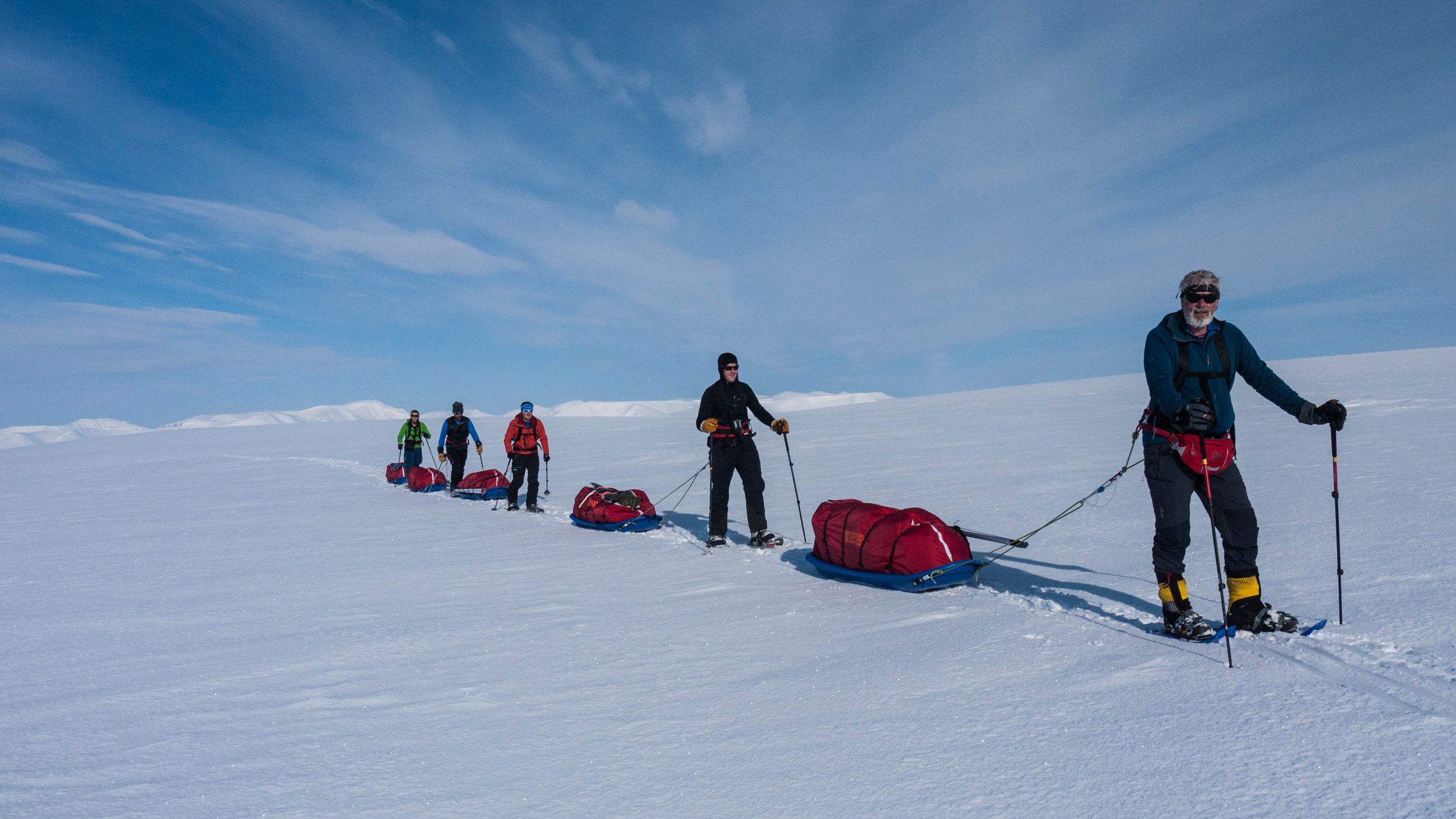
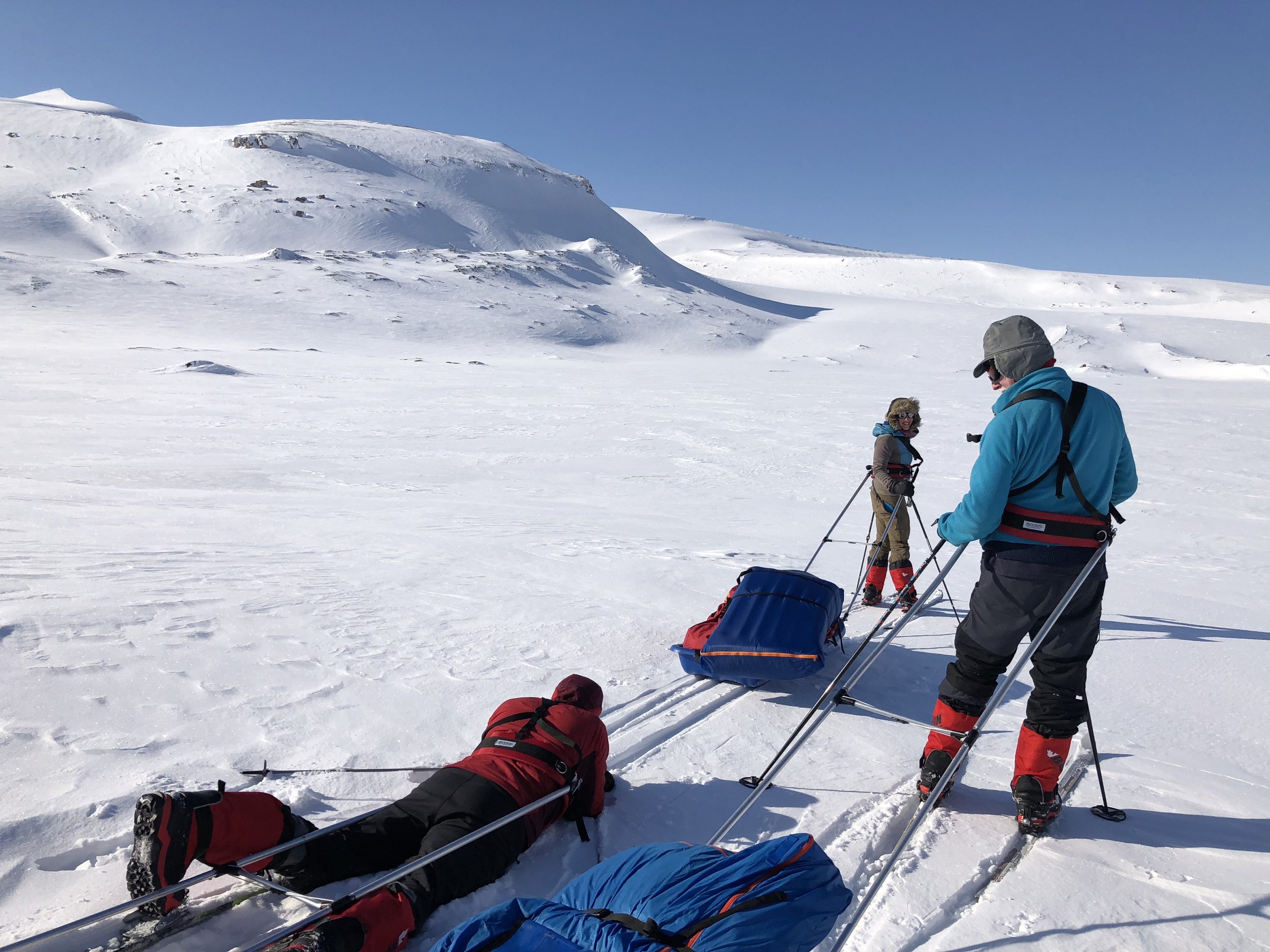

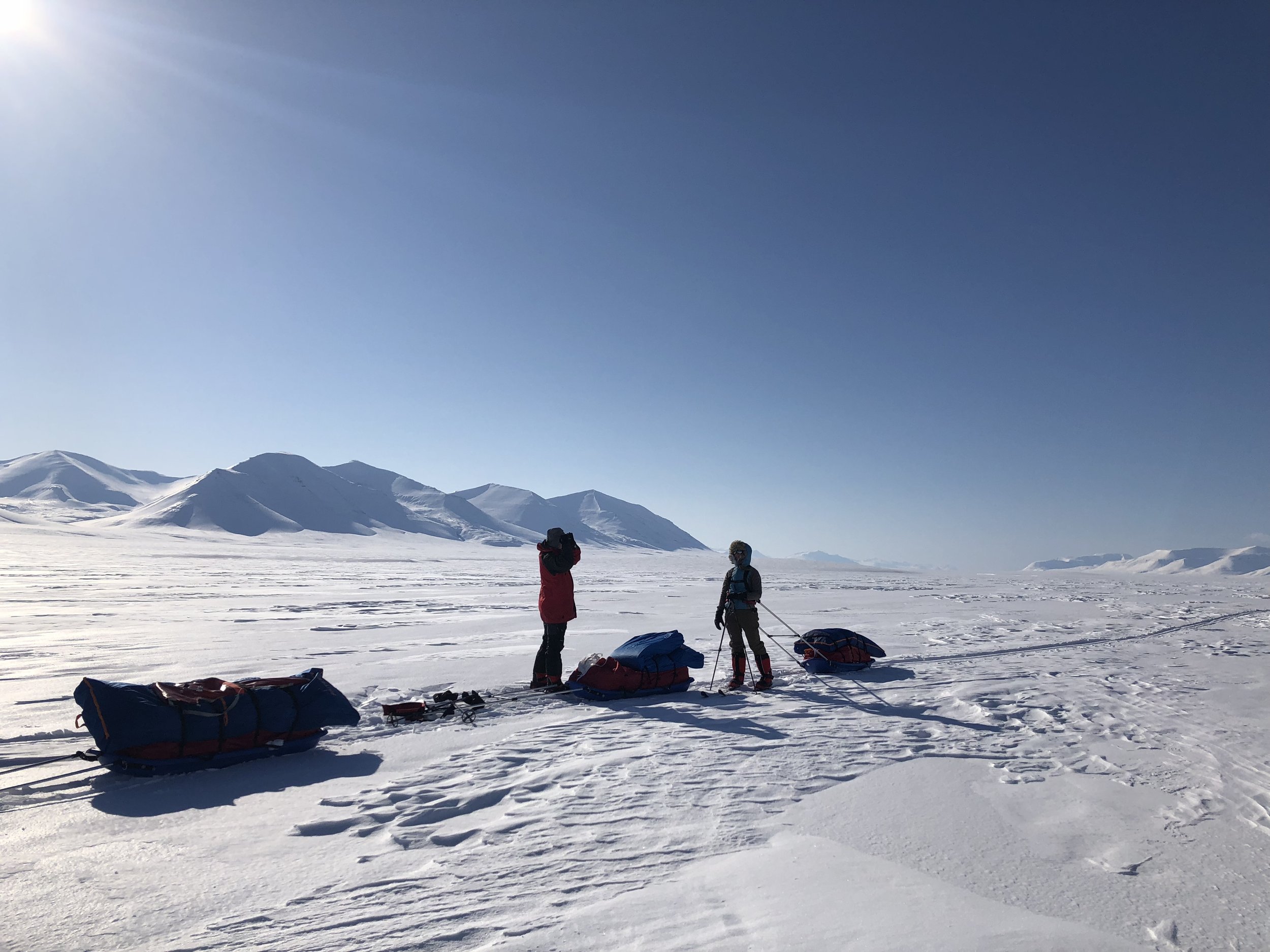

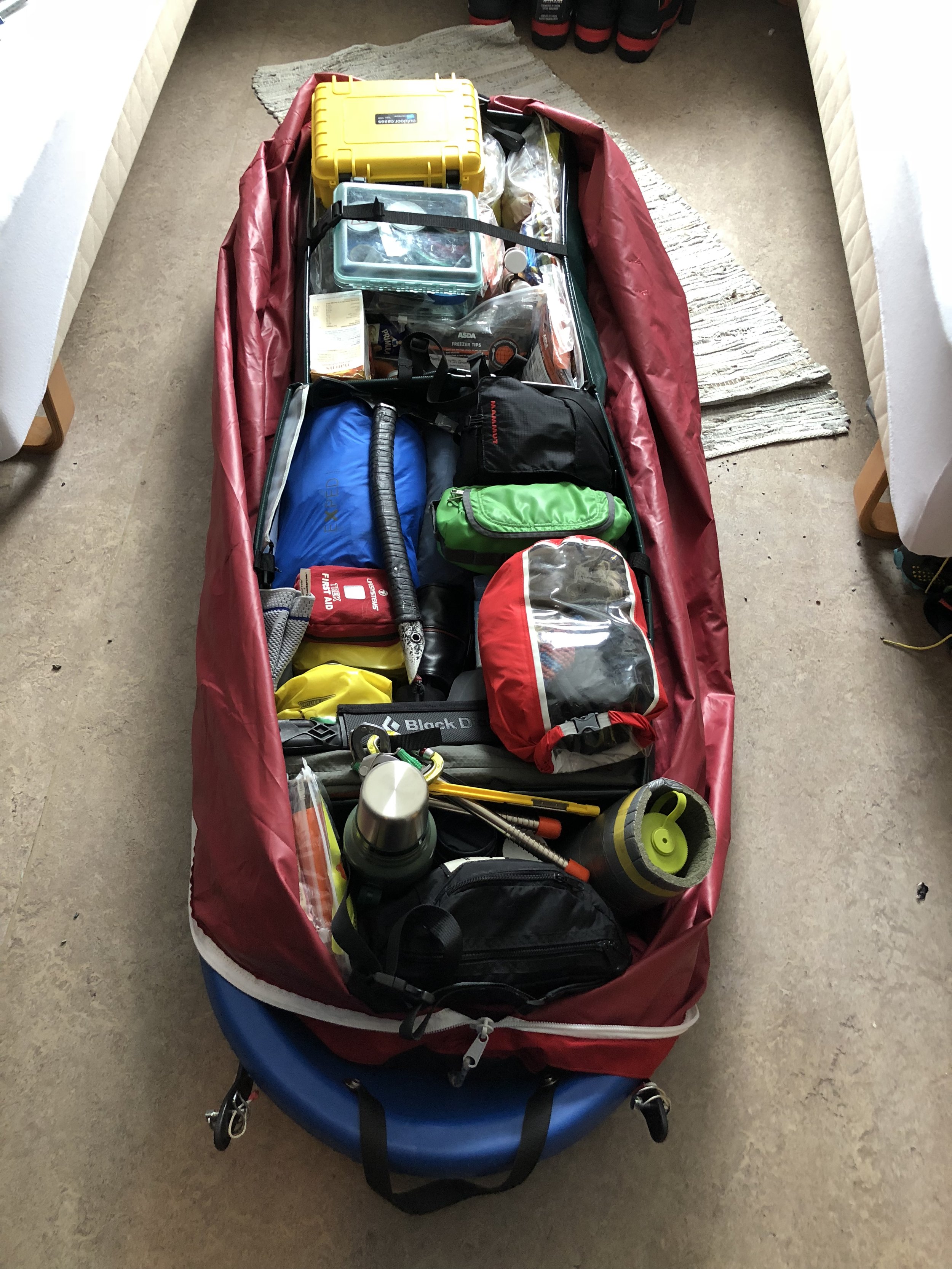

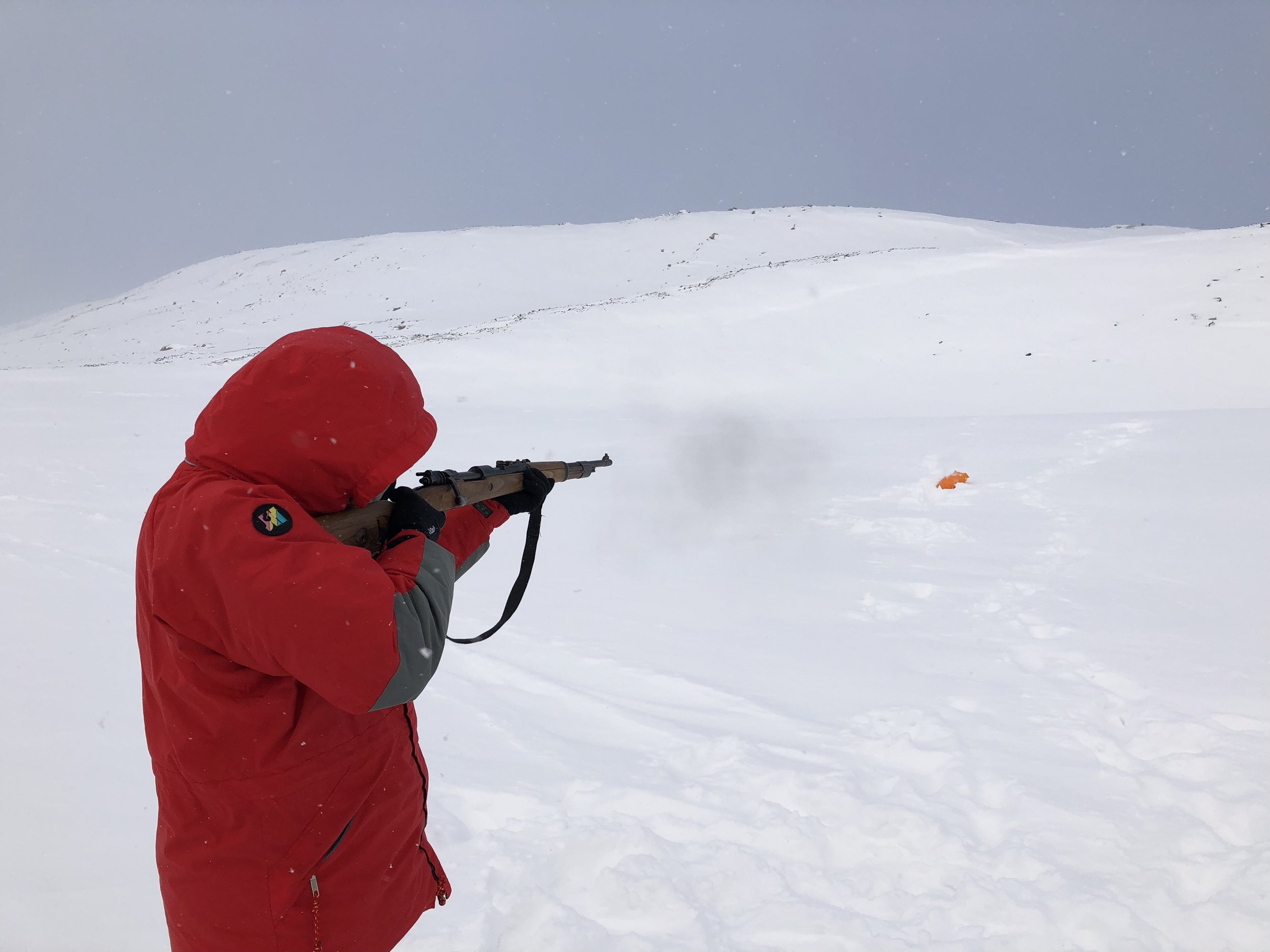











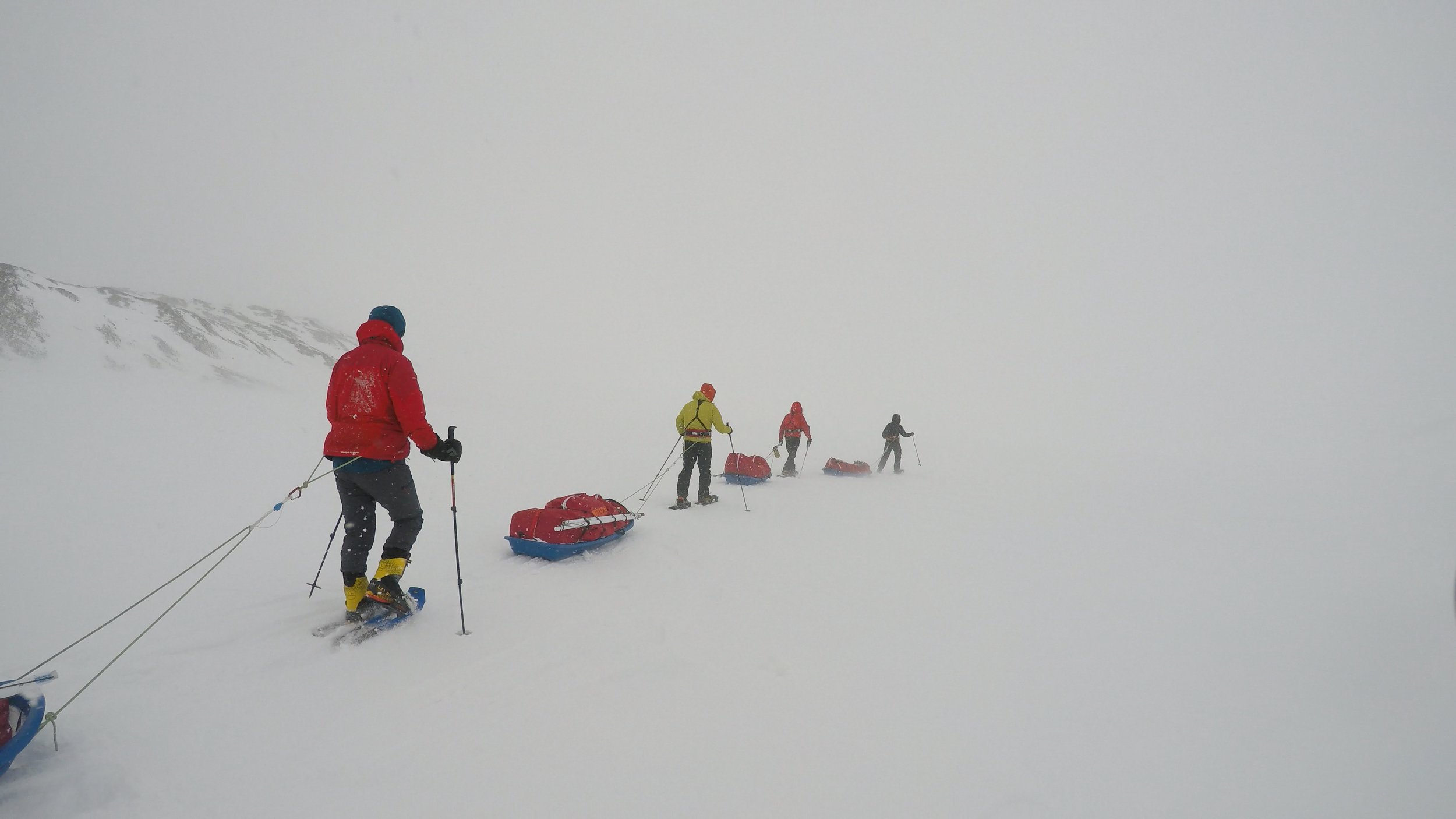
Expedition Safety
Your Safety is Our Top Priority on Every Trip
Your guides will have overall responsibility for polar bear protection and will carry the rifle; they are trained and experienced in polar safety. A thorough safety briefing will take place in Longyearbyen before the expedition begins, as well as during the lead-up to the trip. A UK-based training course will cover the equipment and how to use it, ensuring you feel familiar with handling everything from setting up Hilleberg tents to operating the stoves.
There will always be time to go over skills again and practice. The aim is to get you self-sufficient and confident. By the halfway point of the journey, packing up camp, loading your pulk, and clipping into your bindings will feel like second nature, and the daily routine will become quicker and more efficient.
All of our guides are qualified and have been working with us for many years. They hold up-to-date first aid, Wilderness First Aid, and avalanche safety qualifications. You can visit our Team page to find out more about each guide’s background and experience, and the different qualification schemes.

Giving You Unmatched Expertise and Personalisation on Your Trip
Why Choose Nordur for Your Expedition?
Local knowledge
Nordur stands apart in the world of adventure travel with its deep-rooted local expertise. Led by our founder, Jamie, a seasoned guide with over 17 years experience, and is not only a local but a huge enthusiast of the Scottish wilderness, Nordur offers an authentic experience that larger, outsourced tours simply cannot match. We know every hidden trail and secret spot that makes Scotland unique, offering you a richer, more immersive experience.
Sustainability and Respect
At Nordur, we are deeply committed to preserving the stunning landscapes we explore. We practice Leave No Trace principles and engage in efforts to maintain the natural beauty and integrity of the Scottish wilderness. Choosing Nordur means supporting eco-friendly tourism and contributing to the conservation of these magnificent areas for future generations.
Tailored Adventures
Each expedition is carefully crafted to match the desires and abilities of our guests. Nordur specialises in creating personalised experiences that cater to your interests, whether you're seeking thrilling mountain ascents or serene moments by secluded lochs. Our small group sizes ensure that your journey is attentive and responsive to your pace and preferences.
All-Inclusive Expeditions
From high-quality camping gear to expert navigation and safety equipment, everything you need for your journey is provided. Our packrafts are state-of-the-art and we provide you with full training, ensuring that you can navigate the lochs with ease and safety. With Nordur, you can focus fully on your adventure, knowing that all logistical details are expertly handled.




